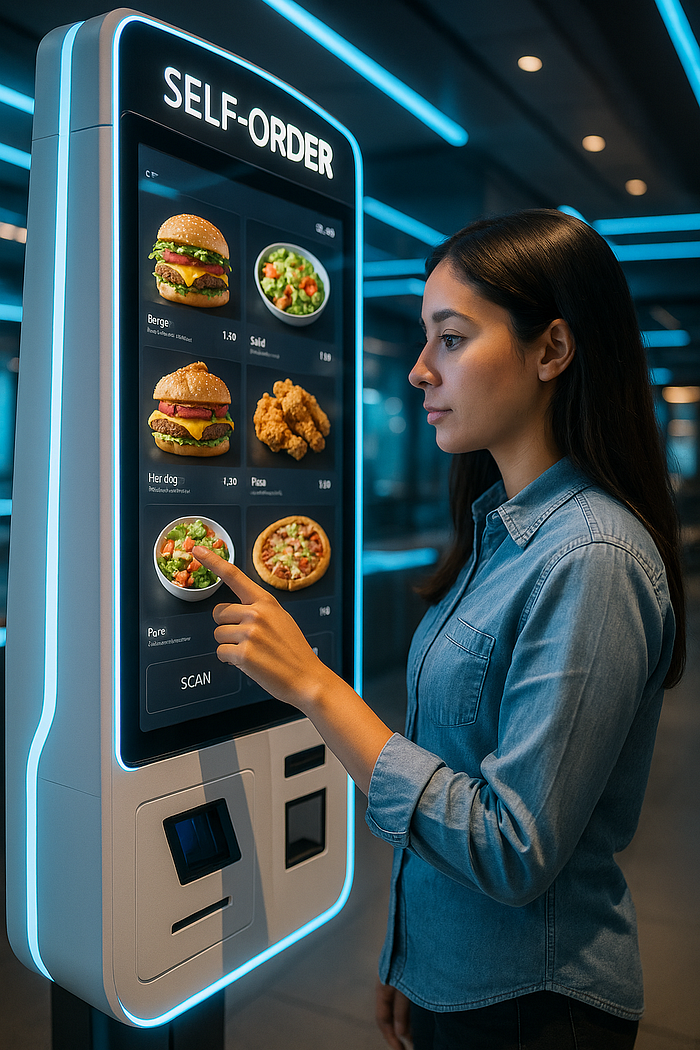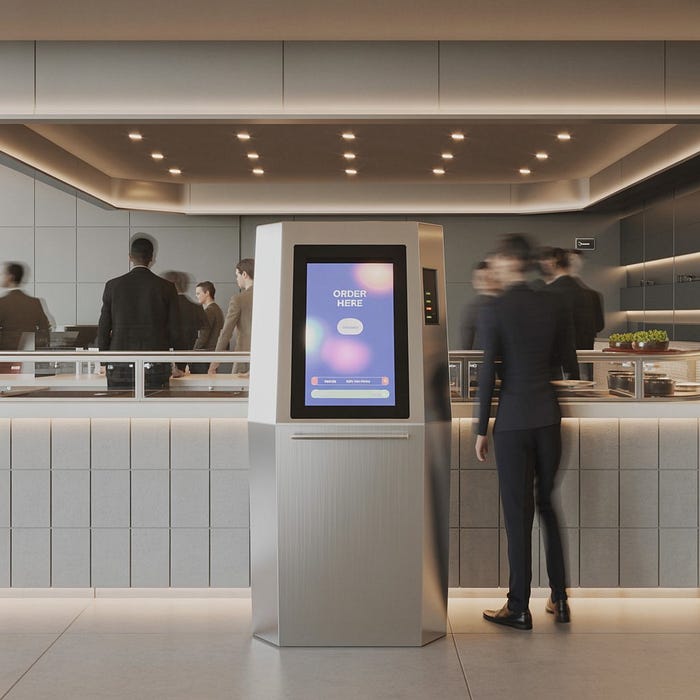
The restaurant industry is undergoing a digital transformation, driven largely by rapid advancements in technology. Among these, self-service kiosks have emerged as a cornerstone of modern dining experiences. As restaurants strive to enhance efficiency, reduce wait times, and deliver more personalized services, kiosks are playing an increasingly vital role. From fast-food chains to fine dining establishments, kiosks are being adopted at a rising rate, signaling a major shift in how consumers interact with food services.
This blog delves into the future of restaurant kiosks, exploring how technological innovations are reshaping customer experiences. From AI and touchless interfaces to sustainability and omnichannel integration, we will uncover the trends shaping the next generation of restaurant technology.
Advancements in Kiosk Technology Enhancing Customer Interaction
As consumer expectations evolve, so must the technology that serves them. The future of kiosks lies in their ability to offer seamless, personalized, and hygienic interactions. Several emerging technologies are making this possible.
Artificial Intelligence and Personalized Ordering
AI is revolutionizing the ordering process by analyzing customer preferences, past orders, and even dietary restrictions. With machine learning algorithms, kiosks can predict what a customer might want to order, thereby speeding up the process and reducing decision fatigue. For example, if a customer frequently orders a vegetarian burger and green smoothie, the kiosk can highlight these items or suggest similar alternatives right at the start.
Personalized ordering not only increases customer satisfaction but also boosts sales by promoting complementary items and upsells based on individual preferences. This creates a win-win scenario for both customers and restaurant owners.
Voice Recognition and Natural Language Processing
Voice-command technology, powered by Natural Language Processing (NLP), is enhancing the accessibility and convenience of kiosk interactions. Customers can now place orders by simply speaking to the kiosk, which understands and processes commands in multiple languages and dialects.
This hands-free interaction is particularly beneficial for individuals with mobility impairments and is more hygienic — a growing concern in a post-pandemic world. As the accuracy of voice recognition technology improves, it is expected to become a staple in future kiosk deployments.
Touchless and Gesture-Based Interfaces
The pandemic has significantly heightened awareness around touch-based interactions. In response, kiosk manufacturers are exploring touchless and gesture-based interfaces. These systems use sensors and cameras to detect hand movements, allowing users to navigate menus and make selections without touching the screen.
Such innovations not only promote hygiene but also appeal to tech-savvy users who appreciate futuristic, interactive experiences. Additionally, these interfaces reduce the need for physical maintenance and cleaning, benefiting operational efficiency.
Integration of Data Analytics to Elevate Customer Experience
Kiosks are no longer standalone devices — they are becoming integrated data hubs that collect, analyze, and respond to customer behavior in real time. This integration of big data and analytics offers a new dimension of service optimization and personalization.
Real-Time Inventory and Menu Updates
Advanced kiosks are linked to the restaurant’s inventory management systems, enabling real-time updates on menu availability. Customers can see which items are in stock, which dishes are sold out, and any ongoing specials — all updated instantly.
This reduces the chances of customer disappointment and improves order accuracy. Furthermore, real-time data helps restaurants manage inventory more effectively, reducing waste and improving profitability.
Customer Behavior Analytics for Targeted Promotions
By analyzing customer interactions, restaurants can gather insights into preferences, peak ordering times, and popular menu items. This data is invaluable for crafting targeted promotions and personalized offers.
For example, a kiosk may offer a discount on a customer’s favorite dessert during their usual visit time, encouraging repeat business. Such strategic promotions not only increase sales but also deepen customer loyalty.
Feedback Collection and Sentiment Analysis
Modern kiosks are equipped to collect customer feedback immediately after the transaction. These systems can ask brief questions or allow open-ended comments, which are then analyzed using sentiment analysis tools.
This real-time feedback loop helps restaurant managers quickly identify service gaps or emerging trends in customer satisfaction. Adjustments can be made proactively, improving the overall dining experience.
Enhancing Accessibility and Inclusivity in Restaurant Kiosks
Inclusivity is a growing priority in the restaurant industry. Kiosks must be designed to serve all customers, including those with disabilities, language barriers, or unique needs. Technological innovation is paving the way for more inclusive solutions.

Multi-Language Support and Visual Aids
To cater to a diverse customer base, kiosks now offer multi-language support. Users can choose from a variety of languages at the start of their interaction, ensuring clarity and comfort throughout the ordering process.
In addition to language options, visual aids such as icons, images, and animations guide users who may have reading difficulties or cognitive disabilities. This combination of language and visual accessibility enhances user confidence and satisfaction.
Ergonomic Design and Physical Accessibility
Ergonomically designed kiosks consider the needs of wheelchair users and individuals with limited mobility. Adjustable screen heights, easily reachable buttons, and intuitive layouts ensure that everyone can use the kiosk without assistance.
Such design considerations go beyond compliance — they reflect a brand’s commitment to inclusivity and customer care, fostering a more welcoming environment.
Assistive Technologies Integration
Kiosks are increasingly being equipped with assistive technologies such as screen readers for the visually impaired, braille panels, and voice-guided instructions. These tools empower individuals with disabilities to place orders independently and confidently.
By embracing these technologies, restaurants not only broaden their customer base but also copyright ethical standards of equality and accessibility.
The Role of Omnichannel Experiences and Mobile Integration
Customers today expect fluidity across digital and physical touchpoints. Kiosks must function as part of an omnichannel ecosystem that includes mobile apps, websites, and in-store services.
Synchronization of Kiosk and Mobile App Ordering
Integrated systems now allow customers to start an order on their mobile app and complete it at a kiosk — or vice versa. This continuity streamlines the customer journey, especially for frequent visitors or loyalty program members.
This feature also enables pre-ordering and queue skipping, reducing wait times and enhancing convenience. By syncing customer data across platforms, restaurants create a unified and satisfying experience.
Loyalty Programs and Contactless Payments Across Platforms
Kiosks are now compatible with various loyalty programs and payment methods, including mobile wallets, NFC cards, and QR codes. Customers can easily earn and redeem rewards, check point balances, and make payments without touching physical cash or cards.
This level of integration not only enhances the user experience but also encourages participation in loyalty programs, fostering long-term customer relationships.
Augmented Reality for Menu Exploration
One of the most exciting trends is the use of Augmented Reality (AR) to visualize menu items. Through AR-enabled kiosks, customers can see 3D renderings of dishes, view portion sizes, and explore ingredients.
This immersive experience reduces uncertainty and builds anticipation, especially for new or unfamiliar dishes. AR adds an element of entertainment, making the ordering process more engaging and informative.
Sustainability and Ethical Considerations in Future Kiosk Development
Beyond functionality and convenience, future kiosk designs must address sustainability and ethical concerns. As environmental awareness grows, restaurants are prioritizing green practices and data responsibility.
Use of Sustainable Materials and Energy-Efficient Hardware
Manufacturers are now producing kiosks with recyclable materials, energy-efficient screens, and low-power processors. These eco-friendly components reduce the carbon footprint of the kiosk without compromising performance.
Restaurants can also benefit from cost savings on energy and maintenance while aligning with customer values around environmental responsibility.
Data Privacy and Security Measures
With kiosks collecting vast amounts of personal data, robust privacy and security measures are critical. Encryption, secure authentication, and compliance with regulations like GDPR and CCPA are becoming standard features.
Transparent data policies and user consent options help build trust, assuring customers that their information is handled responsibly.
Reduction of Food Waste Through Ordering Analytics
By analyzing ordering patterns and customer demand, kiosks can help minimize food waste. Accurate forecasts based on real-time data enable better stock management and menu adjustments.
Restaurants can identify slow-moving items, adjust portion sizes, or offer timely discounts to prevent surplus. This not only supports sustainability goals but also improves cost efficiency.
Conclusion
The future of restaurant kiosks is bright, driven by innovations that enhance personalization, efficiency, inclusivity, and sustainability. From AI-powered recommendations to AR menu previews, kiosks are evolving into intelligent, adaptive systems that redefine the dining experience.
By embracing these trends, restaurants can stay ahead of the curve, delivering superior service and forging deeper connections with their customers. As technology continues to evolve, kiosks will remain a central pillar in creating seamless, enjoyable, and meaningful food service journeys.
Comments on “Future Trends in Restaurant Kiosks and Customer Experience”